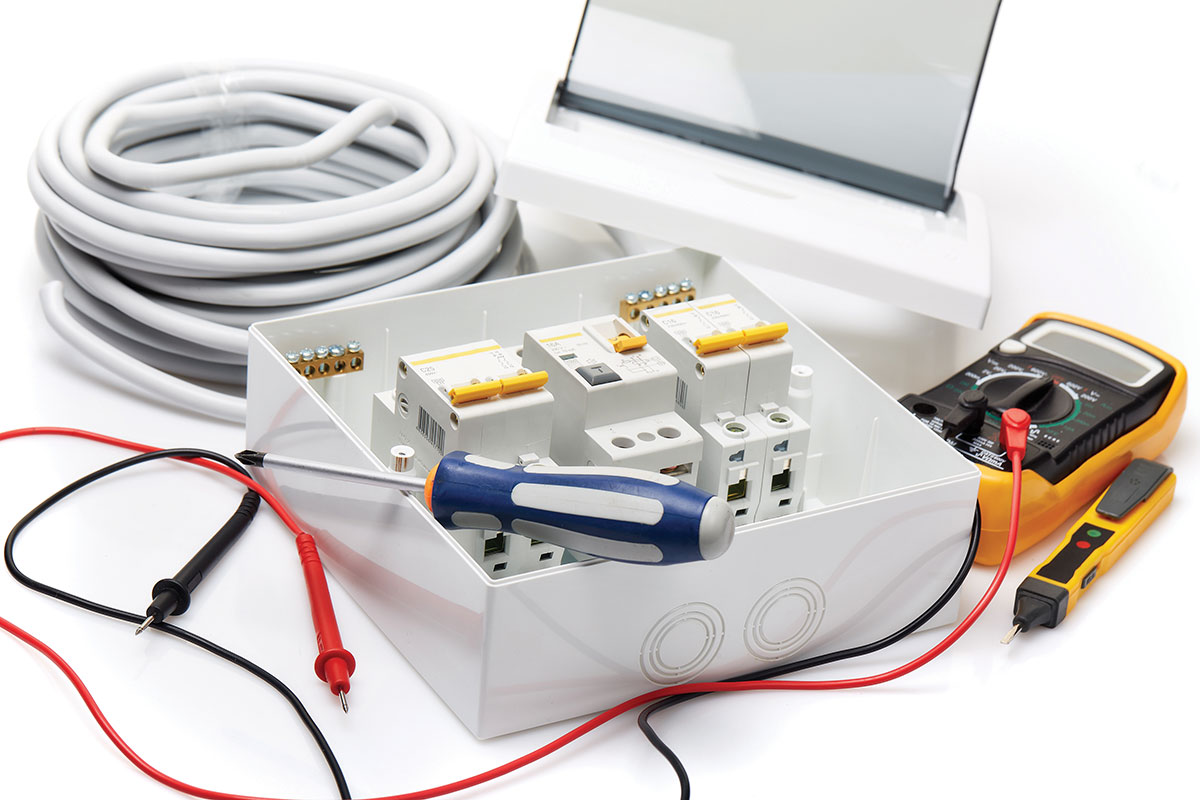Since the original introduction of the Ground-Fault Circuit Interrupters in the 1971 National Electrical Code, these devices have proven to their users and the electrical community that they are worth the added cost during construction or remodeling. Published data shows a decreasing trend in the number of electrocutions in the United States since the introduction of GFCI devices. Unfortunately, no statistics are available for the actual number of injuries prevented by GFCI devices. However, most would agree that the number of lives saved and prevented injuries were substantial. A variety of GFCI’s are available, including portable and plug-in types and circuit-breaker types, types built into attachment plug caps, and receptacle types. Each has a test switch so that the unit can be checked periodically to ensure proper operation. It seems like not too long ago when GFCIs were not available, or were not being used for temporary power. It also seems like everyone (all trades) were cutting off the ground prong on extension cords, so they could plug into old receptacles. Adapters were also a common sight on the construction job, everyone had one tucked away in his toolbox.
We have really come a long way in temporary power procedures, thanks to knowledgeable people who sit on Code panels.
What Is a Ground-Fault Circuit Interrupter?
Definition: A device intended for the protection of personnel that functions to de-energize a circuit or portion thereof within an established period of time when a current to ground exceeds some predetermined value that is less than that required to facilitate the overcurrent protective device of the supply circuit.
Theory of Performance: The hot (ungrounded) conductor and the neutral (grounded) conductor must be installed together as they pass through a differential transformer. The transformer uses a magnetic field to measure the amount of current going to the load against the current returning from the load. The strength of a magnetic field is directly proportional to the current flowing in the conductor. When the amount of current going to the load does not equal the current returning from the load, the induction in the secondary of the differential transformer causes the sensing unit to operate. The sensing unit causes the circuit breaker or the device to trip and open the circuit.
Article 305—Temporary Wiring
305-1 Scope. The provisions of this article apply to temporary electrical power and lighting wiring methods that may be of a class less than would be required for a permanent installation.
305-6. Ground-Fault Protection for Personnel. Ground-fault protection for personnel for all temporary wiring installations shall be provided to comply with (a) and (b). This section shalI apply only to temporary wiring installations used to supply temporary power to equipment used by personnel during construction, remodeling, maintenance, repair, or demolition of buildings, structures, equipment, or similar activities.
(a) Receptacle Outlets. All 125-volt, single-phase, 15- 20-, and 30-ampere receptacle outlets that are not a part of the permanent wiring of the building or structure and that are in use by personnel shall have ground-fault circuit interrupter protection for personnel. If a receptacle(s) is installed or exists as part of the permanent wiring of the building or structure and is used for temporary electrical power, ground-fault circuit interrupter protection for personnel shall be provided. For the purposes of this section, cord sets or devices incorporating listed ground-fault circuit interrupter protection for personnel identified for portable use shall be permitted.
Exception No. 1: Receptacles on a two-wire, single-phase portable or vehicle-mounted generator rated not more than 5kW, where the circuit conductors of the generation are insulated from the generation frame and all other grounded surfaces, shall be permitted without ground-fault protection for personnel.
Exception No. 2: In industrial establishments only, where conditions of maintenance and supervision ensure that only qualified personnel were involved, an assured equipment grounding conductor program as specified in Section 305-6(b)(2) shall be permitted to be utilized for all receptacle outlets.1
Code Making Panel Three (CMP-3) accepted a proposal to delete Exception No. 1 for the 2002 NEC. The substantiation states that Section 250-34 does not permit a two-wire single-phase portable or vehicle-mounted generator to have all circuit conductors insulated from the frame if system grounding is required, which is the case where supplying the receptacles of (a).
There was also a proposal, submitted by Code Making Panel Three to delete 305-6(a) Exception No. 2 in its entirety. The panel recognized that the removal of this exception was long overdue. As indicated in the panel’s substantiation, the sufficient availability and proven safety record of GFCl protection eliminates the need for this exception. Code Panel 3 felt this was a critical step forward because of all the work that is being done in many industrial facilities throughout the country. The safety of the workers is at stake here.
Section 305-6, which provides the ground-fault protection for personnel requirements for temporary wiring, has been revised to clarify that the assured equipment grounding conductor program cannot be used for 125-volt, single-phase, 16-, 20-, and 30-ampere receptacle outlets.
The title of Section 305-6(a) has been changed from “Ground-Fault Circuit Interrupters” to “Receptacle Outlets.” Revised language in (a) makes it clear that all 15-, 20-, and 30-ampere receptacle outlets that are not a part of the permanent wiring of the building or structure, and that are in use by personnel require ground-fault circuit-interrupter protection for personnel. Note that 30-ampere receptacle outlets have been added to this requirement. A number of tools and equipment used by workers today utilize 30-ampere receptacle outlets and should provide the same protection as the 15- and 20-ampere outlets.
The last sentence of (a) has been revised to read: “For the purpose of this section, cord sets or devices incorporating listed ground-fault circuit-interrupter protection for personnel identified for portable use shall be permitted.” This change recognizes the use of GFCI adapters in addition to cord sets.
The requirement for identification as suitable for portable use means that the device has open neutral protection. That is, if the grounded conductor opens for any reason, a relay drops out and the device de-energizes the load. Otherwise, an interrupted grounded conductor would cause the device to fall in its closed position.
A GFCl does not protect a person who comes in contact with two “hot” wires or any “hot” wire and the neutral wire. A GFCI does not protect someone against receiving a shock, but it does limit the time the hazard exists.
A class A ground-fault circuit interrupter trips when the current to ground has a value in the range of 4-6 milliamperes, and a timeframe of 30 milliseconds.
Code Making Panel 3 has taken great strides in the past two cycles, and continues to take strides to prevent injuries or deaths to construction workers. Although it is almost impossible to prevent all accidents, the goal is to prevent anyone from being killed.
1 NFPA 70, National Electrical Code, Article 305, (Quincy, MA: National Fire Protection Association, 1998) p. 70-115 – 70-116.










Find Us on Socials